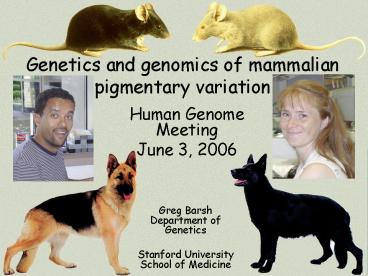Genetics and genomics of mammalian pigmentary variation - PowerPoint PPT Presentation
1 / 29
Title: Genetics and genomics of mammalian pigmentary variation
1
Genetics and genomics of mammalian pigmentary
variation
Human Genome Meeting June 3, 2006
- Greg BarshDepartment of Genetics
- Stanford University School of Medicine
2
Biology of Pigmentation and its Applicationsto
disease
MC4R /- (siblings) / 4 of individuals with
severe childhood-onset obesity (Farooqi et al.)
3
Melanocyte development and biochemistry
Pigment type switching and genetics
4
Molecular causes of Mc1r loss-of-function
DG104 red cow (Klungland, 1995)
DC183 yellow mouse (Robbins, 1993)
R306ter Irish Setter (Newton, 2000)
C33T red chicken (Takeuchi, 1996)
S83F chestnut horse (Marklunk, 1996)
A240T red pig (Kijas, 1998)
R151C red hair (Rees, 1997)
5
(No Transcript)
6
What causes pigmentation patterns?
Arctic Lemming
7
Control of pigment distribution by Agouti
alleles in time and space
dorsum
1-3 4-6 7-9
days of post-natal hair growth
ventrum
light-bellied Agouti (AW)
Agouti (A)
black-and-tan (at)
8
Regional promoters give rise to pigment patterns
9
Reversal of an inverted duplication in the AW to
A mutation
10
(No Transcript)
11
Adaptive coloration in Peromyscus (H. Hoekstra)
Sand Hills of Nebraska"Wide band" Agouti(P.
maniculatus)
Santa Rosa Beach Mouse
Perdido Key Beach Mouse
Alabama Beach Mouse
St. Andrew Beach Mouse
Choctawhatchee Beach Mouse
open sand dunes, lighter sand
increased cover, darker sand
Coastal dunes and barrier islands (P. polionotus)
12
Pigment type-switching in other animals
13
Dominance of Agouti alleles in Mice and Dogs
(Little, 1969)
Mice
Dogs
14
X
Black-and-tan Finnish Lapphund
Black Finnish Lapphund
(Fawn-colored Greyhound Fawn-colored Boxer)
(Newfoundland Black Labrador Dalmation)
15
The Cornell cross (Lust, Todhunter)
40
16 non-black
16 black
16
Genome scan a new black locus (K) in dogs
(Cornell cross)18 animals,155 markersLOD 8.6
attheta 0
17
Epistasis instead of dominance
Mice
Dogs
18
Genetics of domestic dogs as a model system
Domestication from wolves about 15,000 years ago
Patterns of linkage disequilibrium (Linblad-Tohet
al., 2005)
Large Ne short LD(like humans)
Establishment of modern breeds about 250 years ago
Small Ne long LD(like lab mice)
(1) Establish rough subchromosomal position by
association within breeds (2) Fine-map by
association across breeds (assuming ancestral
allele)
19
(No Transcript)
20
(No Transcript)
21
(No Transcript)
22
Single dogs for association study
23
K maps to a gene cluster encoding secreted
cysteine-rich proteins
Dog 16 (356 kb)
25kb
Reversion mapping interval (200 kb)
LD mapping interval (9 kb)
widely expressed
expressed in skin
signal peptide
mature peptide
mutated in fawn vs. black
24
How does the K locus work?
Agouti Mc1r K Phenotype ay fawn
(k) Pheomelanic ay black (K) Eumelanic a
(lof) K or k Eumelanic ay e (lof) K or
k Pheomelanic
K
?
?
K
25
brindled (kbr) is an allele of the K locus
fawn or red (k)
Black (K)
brindle (kbr)
k lt kbr lt K
26
Brindled (kbr) is a segmental duplication
fawn (k) ancestral allele (wolves, coyotes
Black (K) derivative allele (10,000 years ago)
Brindled (kbr) segmental duplication (1000
years ago)
27
Epigenetic control of brindled stripes
black stripe
yellow stripe
28
Building blocks for pigment patterns
Agouti
Black (K)
29
Acknowledgements
Cornell George LustRory TodhunterMichael
Olivier Saskatchewan Sheila Schmutz Harwell Bruc
e Cattanach
Julie Kerns
Sophie Candille
Chris Kaelin

